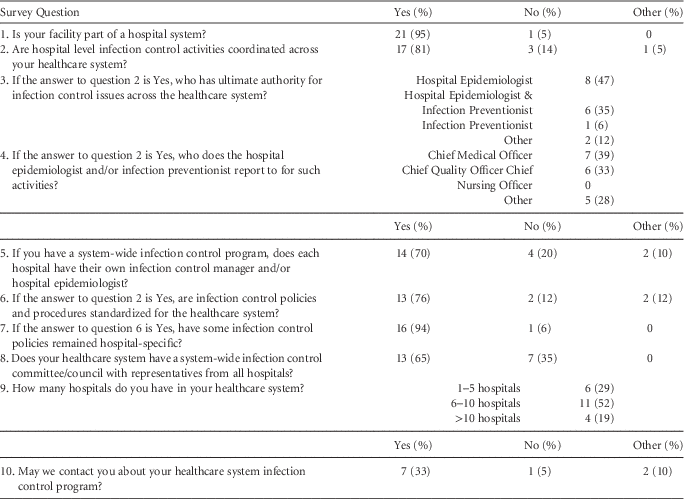To the Editor—Approximately 66% of community hospitals are part of a healthcare system (multihospital or a diversified single hospital system). 1 We sent a 10-question survey electronically to 96 hospital epidemiologists on September 9, 2016, to determine how they organize infection control activities across healthcare system hospitals. Of 22 respondents, 21 were working in a facility that was part of a hospital system. Most respondents noted that infection control activities were coordinated across the healthcare system, with a system-wide hospital epidemiologist alone having ultimate authority in nearly half of the healthcare systems (Table 1). One-third of system-wide infection control leadership reported to a system-wide Chief Medical Officer, and another third reported to a system Chief Quality Officer. Most of these systems reported having standardization of infection control policies and procedures, and two-thirds reported having a system-wide infection control committee.
TABLE 1 Survey Responses

Although greater numbers of US hospitals are part of nongovernmental healthcare systems, the best model to coordinate infection control policies, procedures, and activities remain unknown.Reference Mermel 2 Our survey was not a random sample and likely suffers from ascertainment bias. Nevertheless, we hope that the data presented will stimulate greater discussion and investigation by members of the infection control community so that we can chart a course forward regarding this important and understudied issue. If not, we must assume that administrators will determine the structure of system-wide infection control activities, whether or not we agree with it.
ACKNOWLEDGMENTS
The authors thank the respondents who graciously and voluntarily took the time to complete the survey.
Financial support: No financial support was provided relevant to this article.
Potential conflicts of interest: All authors report no conflicts of interest relevant to this article.



